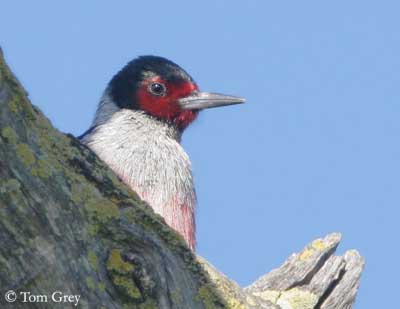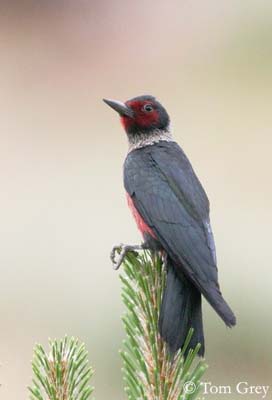
Lewis’s Woodpecker
Melanerpes lewis
Piciforme Order – Picidae Family
BIOMETRICS:
Length : 26 à 28 cm
Wingspan : 49 à 52 cm
Weight : 88 à 138 g
DESCRIPTION:
Lewis’s Woodpecker male has large body. It was named for Meriwether Lewis, an American explorer.
PROTECTION / THREATS / STATUS:
Lewis’s Woodpecker is threatened by habitat loss, with loss of Ponderosa pine forest. Urban development and changes in the range, the use of pesticides, and competition for cavities with European Starlings play an important role in their decline.
Fledglings are heavily preyed upon by raptors, such as American Kestrel.
Lewis’s Woodpecker is high protected, because of its small and patchy distribution, and its low density.
Fr: Pic de Lewis
All : Blutgesichtsspecht
Esp : Carpintero de Lewis
Ital : Picchio di Lewis
Nd : Lewis-specht
Sd : Kråkspett
Russe : Дятел Левиса
Photographs by Tom Grey
His website : Tom Grey's Bird Pictures
Text by Nicole Bouglouan
Sources :
HANDBOOK OF THE BIRDS OF THE WORLD Vol. 7 by Josep del Hoyo-Andrew Elliott-Jordi Sargatal – Lynx Edicions – ISBN: 8487334377
FIELD GUIDE TO THE BIRDS OF NORTH AMERICA by National Geographic Society - National Geographic Society - ISBN: 0792274512
All About Birds (Cornell Lab of Ornithology)
Animal Diversity Web (University of Michigan Museum of Zoology)
What Bird-The ultimate Bird Guide (Mitchell Waite)
Wikipedia (Wikipedia, The Free Encyclopedia)
Bird Web (Seattle Audubon Society)

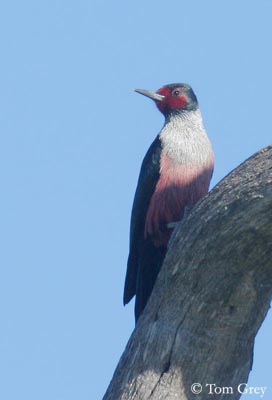
Upperparts are black, with glossy green feathers on back. Underparts are paler, with pale grey collar and breast, and pinkish belly. Tail is strong, with ten pointed stiff feathers. Outer feathers are shorter than median ones. Undertail and underwings are sooty black. Wings are broader than in other Woodpecker’s species.
Head and forehead are black. Face is dark red, including chin and around the eyes. Powerful bill is long, pointed and black. Eyes are dark brown. Legs and feet are grey. Feet have four toes, two rear and two in front, with large curved claws. Legs and feet are covered with wide overlapping scales.
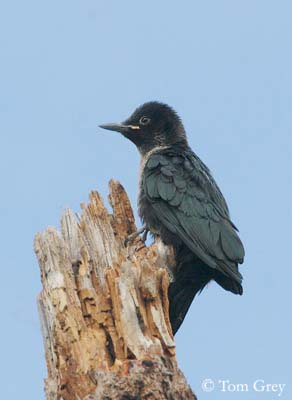
Adult female looks similar, but she is slightly smaller than male.
Juvenile lacks grey collar and red face. Belly is pinkish, but duller than adults, with fine dark streaks on the sides. Upperparts are bronze-green, and head and chest are brownish.
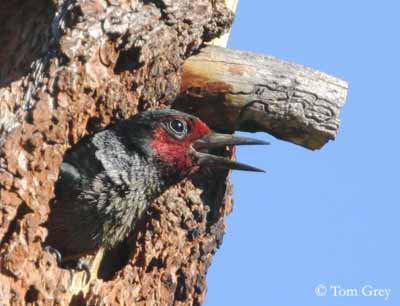
VOICE:
Lewis’s Woodpecker utters low twittering. During breeding season, it utters chirring sounds, and high-pitched squalling, often repeated. Near the nest, they give sharp and short calls.
Drumming is short and weak, followed by individual taps at medium speed.
HABITAT:
Lewis’s Woodpecker lives in open woodlands and areas with scattered trees and snags, and with brushy undergrowth. It breeds in open Ponderosa pine forests or Cottonwood woodlands with ground cover. It may live at high elevations in Ponderosa pine forests.
RANGE:
Lewis’s Woodpecker lives in western to central United States, in different patches from year to year. This species can winter as far south as the US border with Mexico, and summer as far north as Canada.
BEHAVIOUR:
Lewis’s Woodpecker catches insects by gleaning and flycatching. It starts at the base of a tree, and works up or out to the smaller branches. When it’s gleaning on the ground, it doesn’t dig into the soil. It also forages for insects, boring into trunks with its powerful beak, and may catch insects in the air while flying.
In fall and winter, it stores food in bark crevices or cracks in fences.
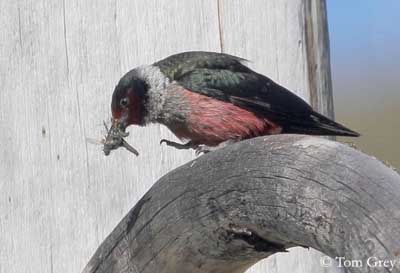
Lewis’s Woodpecker climbs up poles, trees and branches, and may also hops sideways along twigs. It sits on the top of different perches, searching for flying insects. It is generally sat crosswise on a branch. It is also comfortable on the ground for feeding.
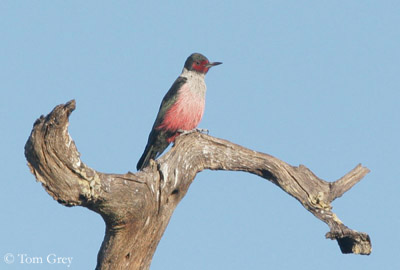
It can be aggressive, in order to defend food storage or nest cavity during nesting period. It performs some displays against intruders, such as bill upwards, open wings or circling flights.
Courtship displays include the same displays to the mate, but also series of different calls and sounds, such as chattering, chirring sounds, and drumming.
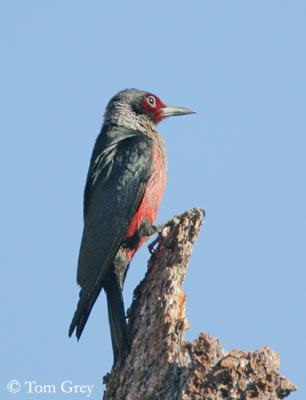
Lewis’s Woodpecker is a migratory bird, moving from place to place. We can see this species in large flocks in fall. It is the most migratory of the Woodpeckers in California.
FLIGHT:
Lewis’s Woodpecker resembles a Crow when flying. It performs strong and slow flight with steady wing beats. It can perform wide circle flights at about 150 metres high, as well as a falcon.
REPRODUCTION:
Lewis’s Woodpeckers nest in cavities that they excavate, and they may return to the same place year after year. Cavities are often located in old trees, either burned or dead, at about 22 to 65 feet above the ground. Both adults excavate, but mainly by male.
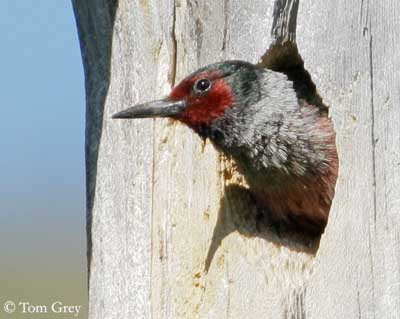
Female lays 5 to 9 opaque white eggs. Incubation lasts about 13 to 14 days, by both adults, male mainly during the night. Both parents feed and brood the young. They fledge at about 28 to 34 days.
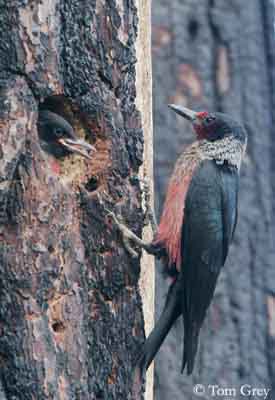
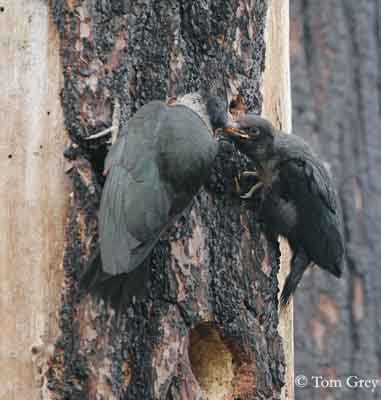
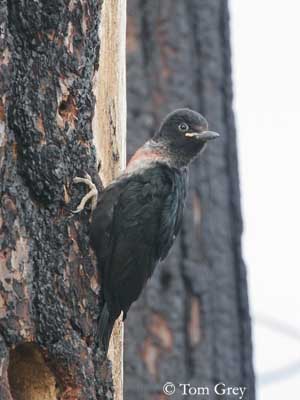
Young remain near the nest site during about 10 days, and they are fed by parents. They climb around the nest tree after leaving the nest cavity, and they stay with adults some days more.
This species produces only one brood per year.
DIET:
Lewis’s Woodpecker feeds mainly on insects such as ants, bees and wasps, beetles and grasshoppers. They also consume acorns, nuts, seeds and berries. Their diet depends of the season.
